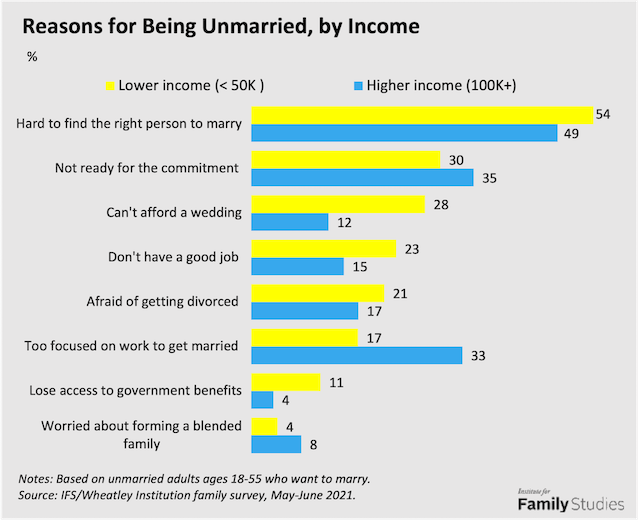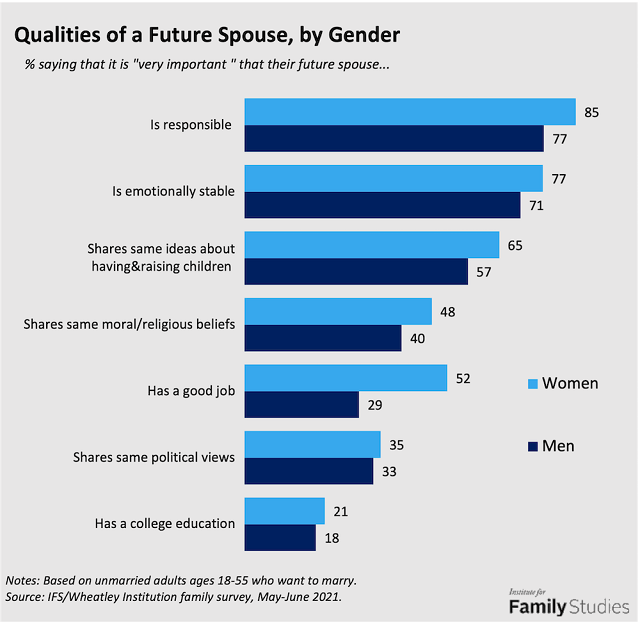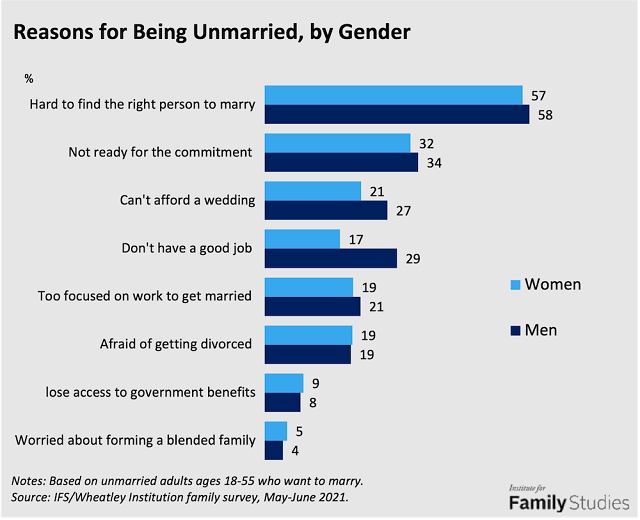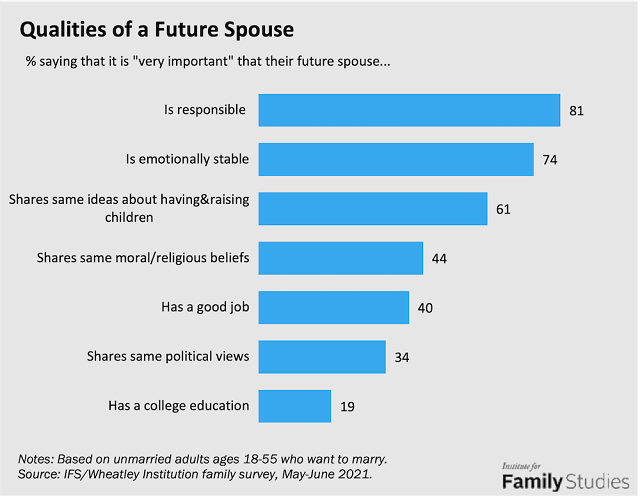Highlights
- “It is hard to find the right person to marry” (58%) and “not ready for the commitment” (33%) are the top two reasons unmarried adults ages 18-55 cited for not being married. Post This
- The top two reasons for not marrying have little to do with money, according to both lower-income and higher-income adults on the marriage market today. Post This
- The top two reasons for singleness are the same for those who make $100K + a year as for those whose income falls below $50K. Post This
Marriage is declining quickly in the United States, especially among lower-income Americans. What’s worse, this “family polarization” by income seems to have deepened since the pandemic began last year, according to our new report. Needless to say, money plays a critical role in this marriage divide. But if you ask individual Americans on the marriage market today why they are not married, surprisingly, their answers have little to do with money.
In a recent survey by the Institute for Family Studies and the Wheatley Institute, we asked unmarried Americans ages 55 or younger who desire marriage about the reasons why they are unmarried. We found that money is not the main reason some Americans remain single,1 not even among those with lower income. Instead, “it is hard to find the right person to marry” (58%) and “not ready for the commitment” (33%) are the top two reasons unmarried adults ages 18-55 cited. In contrast, only about a quarter of unmarried adults chose economic reasons, such as “can’t afford a wedding” or “don’t have a good job.”
The top two reasons for singleness are the same for those who make $100K + a year as for those whose income falls below $50K. More than half of lower-income unmarried adults (54%) said it is difficult for them to find the right person to marry, and about half of those with higher income agreed.

A lack of commitment also matters for both groups: More than one-third of higher-income singles (35%) said they are not ready for commitment, as did 30% of lower-income singles.
Income does make a difference in a few areas: Nearly 3 in 10 lower-income unmarried adults cited “Can’t afford a wedding” as one reason they are single, compared with 12% of singles with higher income. Lower-income singles are also more likely than singles with higher income to cite lacking a good job as a reason for not being married (23% vs. 15%). On the other hand, higher-income singles are much more likely than their counterparts with lower incomes to cite working too much as a reason. A third of higher income singles said that they are “too focused on work to get married,” compared with 17% of lower-income singles.
The so-called “marriage penalty” also plays a much more significant role among lower income adults who are not married. More than one-in-ten said that they would “lose access to government benefits like Medicaid, Child Care, Food Stamps” (if they got married), compared with 4% of unmarried adults with higher incomes. Apparently, there is room for policy interventions to boost marriages among lower income adults who desire marriage.
Unmarried men and women are largely in agreement about the reasons why they remain single. The areas where we see a gender difference are related to income or finances. Men are more likely than women to cite “can’t afford a wedding” (27% vs. 21%) as well as “don’t have a good job” (29% vs. 17%) as reasons why they are unmarried (See Appendix for details).
Since finding the right person is the main obstacle for singles who desire marriage, it is important to understand what traits make someone the “right person” in the eyes of unmarried Americans. According to the same survey, the top qualities for an ideal spouse also have little to do with money. A vast majority of unmarried Americans would like their future spouse to be “responsible” (81%) and “emotionally stable” (74%). More than half (61%) said that it is very important for their future spouse to share the same ideas about having and raising children (see Appendix).
Income doesn’t change people’s preference for an ideal spouse. For both higher-income and lower-income singles, the order of these qualities in a future spouse is the same. The only noticeable differences are that lower-income singles are slightly more likely than those with higher incomes to cite “having a good job” as an important trait of a future spouse (41% vs. 37%). Meanwhile, higher-income Americans pay more attention than their lower-income peers to qualities such as “shares the same political views” (35% vs. 30%) and “has a college education” (25% vs. 18%).
As Pew previously reported, single women tend to put more weight on the job prospects of their future spouse than single men. We find a similar pattern in our new survey: About half of unmarried women (52%) said having a good job is an essential trait for a future spouse, and only 29% of unmarried men agreed. Unmarried women also tend to pay more attention than men to other qualities. For example, 85% of single women would like their future spouse to be responsible, compared with 77% of single men. And 77% of unmarried women said “emotionally stable” is a very important trait in a future spouse, as do 71% of unmarried men.

Overall, we see striking similarities between lower-income and higher-income singles in terms of what they look for in a future spouse: inner qualities such as being responsible and emotionally stable top job and education on the list of desirable traits. The top two reasons for not marrying have little to do with money, according to both lower-income and higher-income adults on the marriage market today.
On the other hand, singles on the opposite income spectrum differ in a few areas. Being able to afford a wedding is a much bigger issue for lower-income Americans than their higher-income peers. Also, for lower-income Americans who desire to marry, a “marriage penalty” is real. For higher-income singles, workism can be detrimental to their personal life.
Of course, lower-income Americans are much more likely to be unmarried than upper-income Americans—78% of men and women ages 18-55 with family incomes of less than 50K a year are unmarried, compared with 34% of Americans with incomes of 100k or more, according to the 2019 American Community Survey. This means that concerns about responsibility, emotional stability, and raising children vis-a-vis finding a marriageable partner would seem to be much more prevalent among lower-income Americans than upper-income Americans. Such concerns also loom large in qualitative accounts of family life among the poor and working class, like Promises I Can Keep by Kathryn Edin and Maria Kefalas.
Wendy Wang is director of research at the Institute for Family Studies. Her work has been featured in The New York Times, The Wall Street Journal, and many other venues.
1. “Single” and “unmarried” are used interchangeably in this article, even though some unmarried adults are living with a partner. Unmarried adults include those who have never been married or divorced or widowed.
Appendix: Additional Figures
















